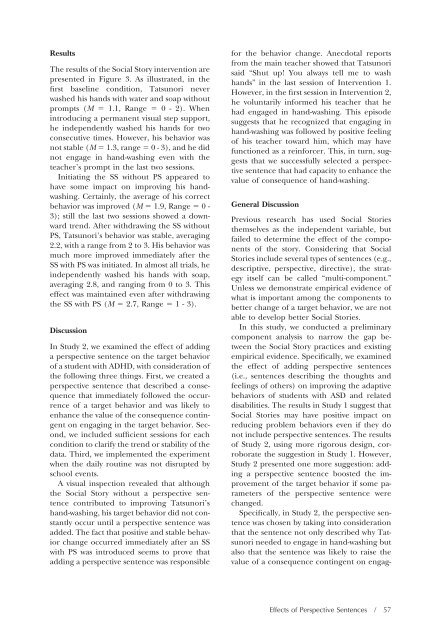Download the Journal (PDF) - Division on Autism and ...
Download the Journal (PDF) - Division on Autism and ...
Download the Journal (PDF) - Division on Autism and ...
Create successful ePaper yourself
Turn your PDF publications into a flip-book with our unique Google optimized e-Paper software.
Results<br />
The results of <str<strong>on</strong>g>the</str<strong>on</strong>g> Social Story interventi<strong>on</strong> are<br />
presented in Figure 3. As illustrated, in <str<strong>on</strong>g>the</str<strong>on</strong>g><br />
first baseline c<strong>on</strong>diti<strong>on</strong>, Tatsunori never<br />
washed his h<strong>and</strong>s with water <strong>and</strong> soap without<br />
prompts (M 1.1, Range 0 - 2). When<br />
introducing a permanent visual step support,<br />
he independently washed his h<strong>and</strong>s for two<br />
c<strong>on</strong>secutive times. However, his behavior was<br />
not stable (M 1.3, range 0 - 3), <strong>and</strong> he did<br />
not engage in h<strong>and</strong>-washing even with <str<strong>on</strong>g>the</str<strong>on</strong>g><br />
teacher’s prompt in <str<strong>on</strong>g>the</str<strong>on</strong>g> last two sessi<strong>on</strong>s.<br />
Initiating <str<strong>on</strong>g>the</str<strong>on</strong>g> SS without PS appeared to<br />
have some impact <strong>on</strong> improving his h<strong>and</strong>washing.<br />
Certainly, <str<strong>on</strong>g>the</str<strong>on</strong>g> average of his correct<br />
behavior was improved (M 1.9, Range 0-<br />
3); still <str<strong>on</strong>g>the</str<strong>on</strong>g> last two sessi<strong>on</strong>s showed a downward<br />
trend. After withdrawing <str<strong>on</strong>g>the</str<strong>on</strong>g> SS without<br />
PS, Tatsunori’s behavior was stable, averaging<br />
2.2, with a range from 2 to 3. His behavior was<br />
much more improved immediately after <str<strong>on</strong>g>the</str<strong>on</strong>g><br />
SS with PS was initiated. In almost all trials, he<br />
independently washed his h<strong>and</strong>s with soap,<br />
averaging 2.8, <strong>and</strong> ranging from 0 to 3. This<br />
effect was maintained even after withdrawing<br />
<str<strong>on</strong>g>the</str<strong>on</strong>g> SS with PS (M 2.7, Range 1 - 3).<br />
Discussi<strong>on</strong><br />
In Study 2, we examined <str<strong>on</strong>g>the</str<strong>on</strong>g> effect of adding<br />
a perspective sentence <strong>on</strong> <str<strong>on</strong>g>the</str<strong>on</strong>g> target behavior<br />
of a student with ADHD, with c<strong>on</strong>siderati<strong>on</strong> of<br />
<str<strong>on</strong>g>the</str<strong>on</strong>g> following three things. First, we created a<br />
perspective sentence that described a c<strong>on</strong>sequence<br />
that immediately followed <str<strong>on</strong>g>the</str<strong>on</strong>g> occurrence<br />
of a target behavior <strong>and</strong> was likely to<br />
enhance <str<strong>on</strong>g>the</str<strong>on</strong>g> value of <str<strong>on</strong>g>the</str<strong>on</strong>g> c<strong>on</strong>sequence c<strong>on</strong>tingent<br />
<strong>on</strong> engaging in <str<strong>on</strong>g>the</str<strong>on</strong>g> target behavior. Sec<strong>on</strong>d,<br />
we included sufficient sessi<strong>on</strong>s for each<br />
c<strong>on</strong>diti<strong>on</strong> to clarify <str<strong>on</strong>g>the</str<strong>on</strong>g> trend or stability of <str<strong>on</strong>g>the</str<strong>on</strong>g><br />
data. Third, we implemented <str<strong>on</strong>g>the</str<strong>on</strong>g> experiment<br />
when <str<strong>on</strong>g>the</str<strong>on</strong>g> daily routine was not disrupted by<br />
school events.<br />
A visual inspecti<strong>on</strong> revealed that although<br />
<str<strong>on</strong>g>the</str<strong>on</strong>g> Social Story without a perspective sentence<br />
c<strong>on</strong>tributed to improving Tatsunori’s<br />
h<strong>and</strong>-washing, his target behavior did not c<strong>on</strong>stantly<br />
occur until a perspective sentence was<br />
added. The fact that positive <strong>and</strong> stable behavior<br />
change occurred immediately after an SS<br />
with PS was introduced seems to prove that<br />
adding a perspective sentence was resp<strong>on</strong>sible<br />
for <str<strong>on</strong>g>the</str<strong>on</strong>g> behavior change. Anecdotal reports<br />
from <str<strong>on</strong>g>the</str<strong>on</strong>g> main teacher showed that Tatsunori<br />
said “Shut up! You always tell me to wash<br />
h<strong>and</strong>s” in <str<strong>on</strong>g>the</str<strong>on</strong>g> last sessi<strong>on</strong> of Interventi<strong>on</strong> 1.<br />
However, in <str<strong>on</strong>g>the</str<strong>on</strong>g> first sessi<strong>on</strong> in Interventi<strong>on</strong> 2,<br />
he voluntarily informed his teacher that he<br />
had engaged in h<strong>and</strong>-washing. This episode<br />
suggests that he recognized that engaging in<br />
h<strong>and</strong>-washing was followed by positive feeling<br />
of his teacher toward him, which may have<br />
functi<strong>on</strong>ed as a reinforcer. This, in turn, suggests<br />
that we successfully selected a perspective<br />
sentence that had capacity to enhance <str<strong>on</strong>g>the</str<strong>on</strong>g><br />
value of c<strong>on</strong>sequence of h<strong>and</strong>-washing.<br />
General Discussi<strong>on</strong><br />
Previous research has used Social Stories<br />
<str<strong>on</strong>g>the</str<strong>on</strong>g>mselves as <str<strong>on</strong>g>the</str<strong>on</strong>g> independent variable, but<br />
failed to determine <str<strong>on</strong>g>the</str<strong>on</strong>g> effect of <str<strong>on</strong>g>the</str<strong>on</strong>g> comp<strong>on</strong>ents<br />
of <str<strong>on</strong>g>the</str<strong>on</strong>g> story. C<strong>on</strong>sidering that Social<br />
Stories include several types of sentences (e.g.,<br />
descriptive, perspective, directive), <str<strong>on</strong>g>the</str<strong>on</strong>g> strategy<br />
itself can be called “multi-comp<strong>on</strong>ent.”<br />
Unless we dem<strong>on</strong>strate empirical evidence of<br />
what is important am<strong>on</strong>g <str<strong>on</strong>g>the</str<strong>on</strong>g> comp<strong>on</strong>ents to<br />
better change of a target behavior, we are not<br />
able to develop better Social Stories.<br />
In this study, we c<strong>on</strong>ducted a preliminary<br />
comp<strong>on</strong>ent analysis to narrow <str<strong>on</strong>g>the</str<strong>on</strong>g> gap between<br />
<str<strong>on</strong>g>the</str<strong>on</strong>g> Social Story practices <strong>and</strong> existing<br />
empirical evidence. Specifically, we examined<br />
<str<strong>on</strong>g>the</str<strong>on</strong>g> effect of adding perspective sentences<br />
(i.e., sentences describing <str<strong>on</strong>g>the</str<strong>on</strong>g> thoughts <strong>and</strong><br />
feelings of o<str<strong>on</strong>g>the</str<strong>on</strong>g>rs) <strong>on</strong> improving <str<strong>on</strong>g>the</str<strong>on</strong>g> adaptive<br />
behaviors of students with ASD <strong>and</strong> related<br />
disabilities. The results in Study 1 suggest that<br />
Social Stories may have positive impact <strong>on</strong><br />
reducing problem behaviors even if <str<strong>on</strong>g>the</str<strong>on</strong>g>y do<br />
not include perspective sentences. The results<br />
of Study 2, using more rigorous design, corroborate<br />
<str<strong>on</strong>g>the</str<strong>on</strong>g> suggesti<strong>on</strong> in Study 1. However,<br />
Study 2 presented <strong>on</strong>e more suggesti<strong>on</strong>: adding<br />
a perspective sentence boosted <str<strong>on</strong>g>the</str<strong>on</strong>g> improvement<br />
of <str<strong>on</strong>g>the</str<strong>on</strong>g> target behavior if some parameters<br />
of <str<strong>on</strong>g>the</str<strong>on</strong>g> perspective sentence were<br />
changed.<br />
Specifically, in Study 2, <str<strong>on</strong>g>the</str<strong>on</strong>g> perspective sentence<br />
was chosen by taking into c<strong>on</strong>siderati<strong>on</strong><br />
that <str<strong>on</strong>g>the</str<strong>on</strong>g> sentence not <strong>on</strong>ly described why Tatsunori<br />
needed to engage in h<strong>and</strong>-washing but<br />
also that <str<strong>on</strong>g>the</str<strong>on</strong>g> sentence was likely to raise <str<strong>on</strong>g>the</str<strong>on</strong>g><br />
value of a c<strong>on</strong>sequence c<strong>on</strong>tingent <strong>on</strong> engag-<br />
Effects of Perspective Sentences / 57
















